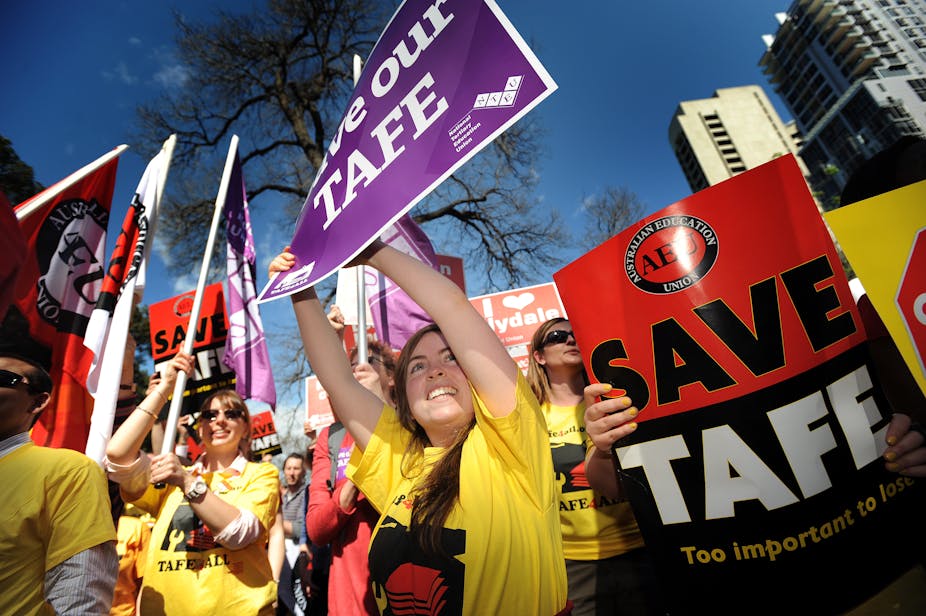In the 40 years since its inception, rarely has TAFE featured as a central platform on which political parties win or lose votes. As such it seldom rates mentions in political campaigns as a distinct sector of education, unlike schools or universities.
But in the recent Victorian state election, cuts to TAFE funding were central to Labor’s campaign. Former Liberal powerbroker Michael Kroger in his election night preview highlighted TAFE as one of the key issues that he felt might count against the Coalition government.
In the election aftermath, federal National Party member for Gippsland Darren Chester nominated TAFE funding as a key state issue which affected the election outcome.
How TAFE became a major political issue in Victoria
That TAFE became a political negative for the Coalition government in Victoria is a paradox, as expenditure on skills training more than doubled during its term in office.
Despite this huge funding increase in 2013, five TAFE institutes in Victoria were rated as having a high financial sustainability risk and eight as medium risk with an accumulated deficit across the 14 institutes of more than A$16 million. This is despite widespread staff cuts, course cancellations and campus closures which had significant local impacts and consequential political fallout for the government.

However, reasons for the parlous position of TAFE in Victoria extend back before the Coalition government. In 2008, the Brumby Labor government announced the introduction of the Victorian Training Guarantee. Under the Victorian Training Guarantee eligible students were able to choose their course from any VET provider, increasing TAFE’s competition. A similar policy is now being implemented in all states and territories.
TAFEs have a public role to uphold
TAFE’s “public roles” can include maintaining a wide range of courses even when there is low demand, maintaining campuses across Victoria and opening new campuses in areas of high population growth, enrolling students from diverse education and socio-economic backgrounds, providing specialist training in niche industry areas, providing counselling and library services, student facilities and meeting specific policy objectives of government, for example retraining workers in manufacturing industries.
While other providers can provide some or many of these roles they can opt in or out of them as they see fit. Most private providers also operate a very low cost delivery model with far less infrastructure and fewer services than TAFE.
Under the initial reform package introduced by the Brumby government, TAFE institutions were paid an additional rate per student relative to other providers and were allocated special funding for their role as public providers. This funding helped to cushion TAFE from the full impact of the new competition.
However, there was a strong view from economic agencies that there should be a level playing field in the VET market, and TAFE should just be seen as any other provider to be funded the same as other registered training organisations regardless of its obligations as a public provider.
This view fully prevailed in late 2011 when to help manage a cost blow out in the Victorian Training Guarantee, TAFE institutes with revenue of more than $100 million had their supplementary funding cut by the Coalition government. These cuts were then extended to all TAFE institutes in 2012. This resulted in funding cuts of more than A$300 million with widespread job losses, course cuts and campus and facility closures.
Subsidy levels for a range of VET courses assessed as low priority were also cut in 2012. Although these reductions applied to all providers, the impact on TAFE was felt more strongly than private providers due to its high fixed cost base in terms of campuses, facilities and ongoing staffing in areas such as hospitality.
Even though TAFE enrolments increased under the Victorian Training Guarantee, revenue from enrolments fell well short of the additional funding previously allocated for TAFE’s “public role”.
Learning from Victoria
The factors leading to the financial crisis in TAFE are complex and varied. They flow from the removal of funding for TAFE’s public role and changes in course funding levels but also the inability of many institutes and the TAFE system generally to capitalise on the significant growth opportunities provided by the Victorian Training Guarantee.
Other states have taken a more cautious approach in introducing competitive and student demand driven funding in VET and will have watched with interest the political fallout from Victoria. Most have initiated major reforms to TAFE in advance of the introduction of contestable funding and have far more explicitly recognised the importance of a strong TAFE system.
The lessons are clear. Governments should value and be clear about the role of TAFE as the public VET provider and be prepared to fund those roles. But TAFE’s future role should be as a high quality and highly responsive provider in emerging national and international VET and tertiary education markets, not as a government funded monopoly.

